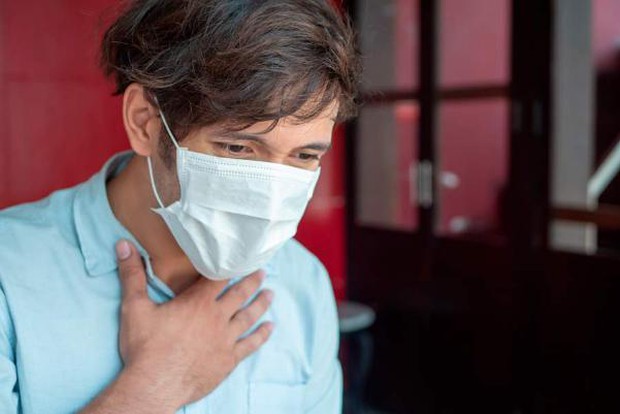Post-COVID-19 nausea, how to treat?
1. Why post-COVID-19 causes diseasenausea and vomiting?
Nausea is a very unpleasant sensation (wanting to vomit) due to nerve stimulation of the vomiting center in the medulla oblongata. Vomiting is the forceful expulsion of gastric contents caused by involuntary contraction of the abdominal wall muscles when the cardiac and lower esophageal sphincters relax. Nausea and vomiting are two symptoms that often go together.
The cause could be:
– SARS-CoV-2 penetrates directly through the ACE2 receptor in the gastrointestinal epithelium. Scientists have observed how SARS-CoV-2 can infect human digestive tract cells. They also found that even a small amount of ACE2 was enough for viral entry.
SARS-CoV-2 is usually localized to epithelial cells of the stomach, duodenum, and rectum. If the immune system is not strong enough to defeat the virus, SARS-CoV-2 will multiply rapidly. Thereby causing a decrease in the amount of ACE2 and destruction of the host’s cells. Meanwhile, a decrease in ACE2 leads to a decrease in the ability to protect the organ. As a result, digestive function is compromised and inflammation accelerates, which in turn causes nausea and vomiting.
The immune system response will produce proinflammatory cytokines and chemokines. Simultaneously activates a T-cell response to clear the virus in mild cases. However, in more severe cases, viral tissue damage can trigger monocytes, macrophages, and dendritic cells to overproduce proinflammatory cytokines, leading to a “cytokine storm”. This systemic inflammatory response can damage many organs and systems in the body, including the digestive system.
– May be due to side effects in the treatment of COVID-19 such as when taking remdesivir.
– This is a common cause of post-COVID-19 vomiting and nausea: In addition to the crisis of the health system, prolonged social distancing and economic burdens put patients at high risk of experiencing serious health problems. mental health problems. Especially vulnerable people such as healthcare workers, children and the elderly. Although specific data are not available, psychological factors play an important role in leading to post-COVID-19 symptoms.

Many people with COVID-19 after recovering from the disease experience symptoms of nausea and vomiting.
2. How to manage vomiting and nausea after COVID-19?
When infected with COVID-19, nausea and vomiting will appear acute (high frequency) accompanied by other gastrointestinal symptoms, especially diarrhea, abdominal pain, loss of appetite. These symptoms may precede respiratory manifestations.
However, post-COVID-19 vomiting and nausea occur infrequently but still affect the patient’s quality of life. Medicines can be used to remedy this situation. In addition, dietary and lifestyle interventions will also help increase effectiveness.
2.1. Treating post-COVID-19 nausea with medication
– Prochlorperazine
This is an antiemetic that partially relieves acute nausea and vomiting (in acute gastroenteritis). It can cause side effects (anticholinergic) such as blurred vision, confusion, constipation, dry eyes, urinary retention, and heart rhythm disturbances. In addition, the drug can also cause dizziness, orthostatic hypotension, drowsiness and sedation.
Pediatric patients are particularly sensitive to the sedative effects induced by prochlorperazine. Extrapyramidal reactions, including neurosis, acute dystonia, drug-induced parkinsonism, and tardive dyskinesia have been reported with the use of prochlorperazine. Therefore, prochlorperazine should not be used in pregnant women, patients with impaired liver and kidney function, epilepsy, children < 2 years old or weighing < 9 kg or having one of the above conditions.
– Metoclopramide
Metoclopramide directly affects the chemoreceptor trigger zone (CTZ), by blocking dopamine receptors. This leads to an increase in the CTZ threshold and a decrease in the sensitivity of the visceral nerves that transmit impulses from the gastrointestinal tract to the vomiting center. It also enhances gastric emptying (to minimize stasis before vomiting).
The drug is used for the symptomatic treatment and prevention of nausea, and for the treatment of late (non-acute) vomiting. Note, the drug is contraindicated in cases of mechanical obstruction, gastrointestinal perforation, gastrointestinal bleeding, history of epilepsy, Parkinson’s, adrenal myeloma and children under 1 year of age.
Common side effects of metoclopramide include diarrhea, nausea, unusual fatigue and weakness, somnolence, and acute dystonia.
– Domperidone
It is also an anti-dopamine drug, but with less ability to penetrate the blood-brain barrier. Therefore, there is much less sedation and dystonia than metoclopramide. Domperidone is indicated for the short-term treatment of severe nausea and vomiting.
The drug is contraindicated in patients with hepatic impairment (moderate and severe), heart disease, gastrointestinal bleeding or perforation, mechanical intestinal obstruction and pregnant women.
2.2. Non-drug treatment
Post-COVID-19 nausea and vomiting can be treated with non-pharmacological measures:
– Acupressure
Reflexology uses pressure to stimulate certain points on the body to relieve symptoms. Pressing on the Neiguan point on the palm of your hand can help relieve nausea and vomiting. To massage this point can be done in the following way:
Place three fingers across the wrist.
– Place your thumb under the index finger.
Rub the spot in a firm, circular motion for two to three minutes.
– Repeat on the other wrist.
– Use refined ginger juice
When the symptoms of post-COVID-19 nausea persist, using refined ginger water will be effective.
– Eat easily digestible food, Divide into several meals, avoid eating too much at one meal that can cause vomiting.
– Eat homemade food, Limit processed foods.

Cool air when opening the window will help reduce discomfort and nausea.
3. The advice of doctor
To treat vomiting and nausea after COVID-19 should note:
– Only use anti-emetics when advised and prescribed by a doctor.
Watch out for other symptoms of post-COVID-19 syndrome. A doctor should be consulted if fatigue persists and tends to increase.
– Sit up, lean back slightly or move when feeling nauseous.
– Open a window or sit in front of a fan. Because cool air will help reduce discomfort.
– Apply a cool compress with a warm towel on the back of your neck to stabilize the temperature and reduce discomfort.
– Breathe deeply, relax if nausea due to stress, excessive anxiety.
at Blogtuan.info – Source: Kenh14.Vn – Read the original article here



